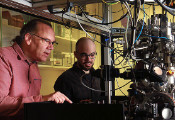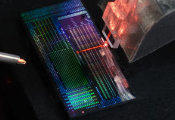A Novel Framework for Describing How Certain Quantum Systems Avoid Equilibrium
November 18, 2024 -- When many quantum particles evolve over time, they typically end up arriving to an equilibrium state through a process called thermalization. Something similar happens in many classical systems. For example, if you place an ice cube in a thermos with water, the ice melts and the final (equilibrium) state is just colder water than before.
In classical physics, complex systems eventually reach equilibrium (if you wait long enough, the ice always melts). However, certain quantum many-body systems defy this norm. For them, thermalization does not occur, and the system remains out of equilibrium. That is the case of a large class of strongly disordered systems —where features like particle interactions or individual energies exhibit a certain degree of randomness. This behavior is due to many-body localization (MBL), a mechanism that preserves the system’s initial conditions over time.
Local integrals of motion (LIOMs) constitute a theoretical framework broadly used for the study of MBL. Nevertheless, a recent article published in Physical Reviews Letters led by Uniwersytet Jagielloński and with the collaboration of ICFO researchers Dr. Piotr Sierant and ICREA Prof. Maciej Lewenstein shows that LIOMs are insufficient to describe the behavior of a wide class of systems, in particular, those with more complex types of disorder. They propose a new framework, the real space renormalization group for excited states (RSRG-X), which can explain MBL in a larger amount of quantum many-body systems.
The team knew that LIOMs can capture the behavior of MBL when the disorder of the system affects properties of particles individually (on-site disorder). However, they suspected that LIOMs failed to account for systems where randomness influences the interactions between particles (bond disorder).
To test this hypothesis, researchers applied RSRG-X to a bond-disordered chain of spin particles (that is, particles that behave like tiny magnets). The results showed that, indeed, RSRG-X provides a theoretical description of MBL in such systems, where LIOMs do not even exist. Their framework uncovers new features of MBL in quantum many-body systems, including the presence of anomalously small energy level spacings, the emergence of non-trivial entanglement structures and observable quantities that enable experimental demonstration of the phenomenon. The obtained description turned out to be qualitatively accurate and, this way, researchers demonstrated the validity of the procedure.
“We have provided a framework applicable to a wider range of systems and, thanks to that, we have shown that the physics of MBL is richer than previously thought”, explains Dr. Piotr Sierant. Furthermore, the novel approach has implications which can be tested in experiments, for instance, with ultracold atom gases or superconducting qubits. Dr. Sierant adds: “Rydberg atoms are just one platform, among many others, in which the systems we have in mind could be realized. That is very convenient because, as theoreticians, we would be thrilled to see our framework implemented in a real-world scenario.”




































